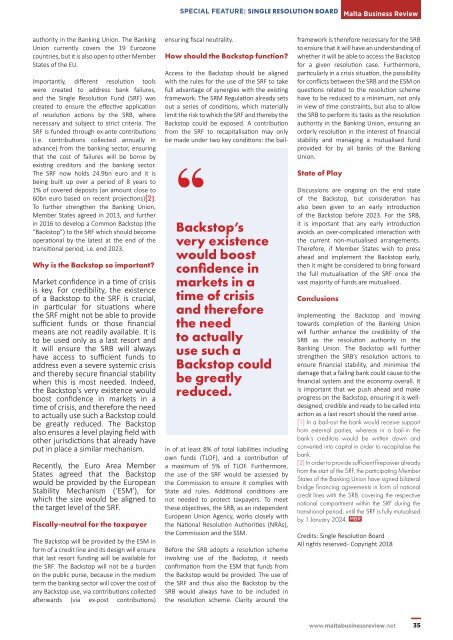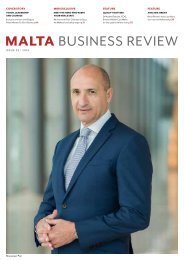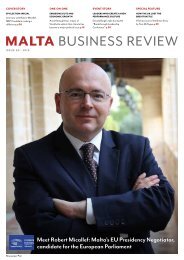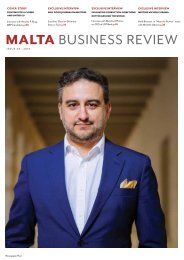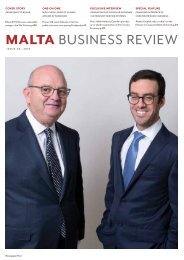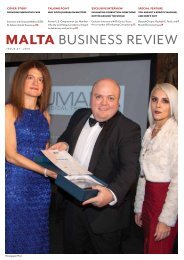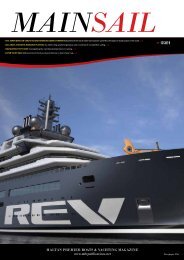MBR_ISSUE 46_NOV_DEC_18_LowRes
Create successful ePaper yourself
Turn your PDF publications into a flip-book with our unique Google optimized e-Paper software.
SPECIAL FEATURE: SINGLE RESOLUTION BOARD<br />
Malta Business Review<br />
authority in the Banking Union. The Banking<br />
Union currently covers the 19 Eurozone<br />
countries, but it is also open to other Member<br />
States of the EU.<br />
Importantly, different resolution tools<br />
were created to address bank failures,<br />
and the Single Resolution Fund (SRF) was<br />
created to ensure the effective application<br />
of resolution actions by the SRB, where<br />
necessary and subject to strict criteria. The<br />
SRF is funded through ex-ante contributions<br />
(i.e. contributions collected annually in<br />
advance) from the banking sector, ensuring<br />
that the cost of failures will be borne by<br />
existing creditors and the banking sector.<br />
The SRF now holds 24.9bn euro and it is<br />
being built up over a period of 8 years to<br />
1% of covered deposits (an amount close to<br />
60bn euro based on recent projections)[2].<br />
To further strengthen the Banking Union,<br />
Member States agreed in 2013, and further<br />
in 2016 to develop a Common Backstop (the<br />
“Backstop”) to the SRF which should become<br />
operational by the latest at the end of the<br />
transitional period, i.e. end 2023.<br />
Why is the Backstop so important?<br />
Market confidence in a time of crisis<br />
is key. For credibility, the existence<br />
of a Backstop to the SRF is crucial,<br />
in particular for situations where<br />
the SRF might not be able to provide<br />
sufficient funds or those financial<br />
means are not readily available. It is<br />
to be used only as a last resort and<br />
it will ensure the SRB will always<br />
have access to sufficient funds to<br />
address even a severe systemic crisis<br />
and thereby secure financial stability<br />
when this is most needed. Indeed,<br />
the Backstop’s very existence would<br />
boost confidence in markets in a<br />
time of crisis, and therefore the need<br />
to actually use such a Backstop could<br />
be greatly reduced. The Backstop<br />
also ensures a level playing field with<br />
other jurisdictions that already have<br />
put in place a similar mechanism.<br />
Recently, the Euro Area Member<br />
States agreed that the Backstop<br />
would be provided by the European<br />
Stability Mechanism (‘ESM’), for<br />
which the size would be aligned to<br />
the target level of the SRF.<br />
Fiscally-neutral for the taxpayer<br />
The Backstop will be provided by the ESM in<br />
form of a credit line and its design will ensure<br />
that last resort funding will be available for<br />
the SRF. The Backstop will not be a burden<br />
on the public purse, because in the medium<br />
term the banking sector will cover the cost of<br />
any Backstop use, via contributions collected<br />
afterwards (via ex-post contributions)<br />
ensuring fiscal neutrality.<br />
How should the Backstop function?<br />
"Backstop’s<br />
very existence<br />
would boost<br />
confidence in<br />
markets in a<br />
time of crisis<br />
and therefore<br />
the need<br />
to actually<br />
use such a<br />
Backstop could<br />
be greatly<br />
reduced.<br />
Access to the Backstop should be aligned<br />
with the rules for the use of the SRF to take<br />
full advantage of synergies with the existing<br />
framework. The SRM Regulation already sets<br />
out a series of conditions, which materially<br />
limit the risk to which the SRF and thereby the<br />
Backstop could be exposed. A contribution<br />
from the SRF to recapitalisation may only<br />
be made under two key conditions: the bailin<br />
of at least 8% of total liabilities including<br />
own funds (TLOF), and a contribution of<br />
a maximum of 5% of TLOF. Furthermore,<br />
the use of the SRF would be assessed by<br />
the Commission to ensure it complies with<br />
State aid rules. Additional conditions are<br />
not needed to protect taxpayers. To meet<br />
these objectives, the SRB, as an independent<br />
European Union Agency, works closely with<br />
the National Resolution Authorities (NRAs),<br />
the Commission and the SSM.<br />
Before the SRB adopts a resolution scheme<br />
involving use of the Backstop, it needs<br />
confirmation from the ESM that funds from<br />
the Backstop would be provided. The use of<br />
the SRF and thus also the Backstop by the<br />
SRB would always have to be included in<br />
the resolution scheme. Clarity around the<br />
framework is therefore necessary for the SRB<br />
to ensure that it will have an understanding of<br />
whether it will be able to access the Backstop<br />
for a given resolution case. Furthermore,<br />
particularly in a crisis situation, the possibility<br />
for conflicts between the SRB and the ESM on<br />
questions related to the resolution scheme<br />
have to be reduced to a minimum, not only<br />
in view of time constraints, but also to allow<br />
the SRB to perform its tasks as the resolution<br />
authority in the Banking Union, ensuring an<br />
orderly resolution in the interest of financial<br />
stability and managing a mutualised fund<br />
provided for by all banks of the Banking<br />
Union.<br />
State of Play<br />
Discussions are ongoing on the end state<br />
of the Backstop, but consideration has<br />
also been given to an early introduction<br />
of the Backstop before 2023. For the SRB,<br />
it is important that any early introduction<br />
avoids an over-complicated interaction with<br />
the current non-mutualised arrangements.<br />
Therefore, if Member States wish to press<br />
ahead and implement the Backstop early,<br />
then it might be considered to bring forward<br />
the full mutualisation of the SRF once the<br />
vast majority of funds are mutualised.<br />
Conclusions<br />
Implementing the Backstop and moving<br />
towards completion of the Banking Union<br />
will further enhance the credibility of the<br />
SRB as the resolution authority in the<br />
Banking Union. The Backstop will further<br />
strengthen the SRB’s resolution actions to<br />
ensure financial stability, and minimise the<br />
damage that a failing bank could cause to the<br />
financial system and the economy overall. It<br />
is important that we push ahead and make<br />
progress on the Backstop, ensuring it is welldesigned,<br />
credible and ready to be called into<br />
action as a last resort should the need arise.<br />
[1] In a bail-out the bank would receive support<br />
from external parties, whereas in a bail-in the<br />
bank’s creditors would be written down and<br />
converted into capital in order to recapitalise the<br />
bank.<br />
[2] In order to provide sufficient firepower already<br />
from the start of the SRF, the participating Member<br />
States of the Banking Union have signed bilateral<br />
bridge financing agreements in form of national<br />
credit lines with the SRB, covering the respective<br />
national compartment within the SRF during the<br />
transitional period, until the SRF is fully mutualised<br />
by 1 January 2024. <strong>MBR</strong><br />
Credits: Single Resolution Board<br />
All rights reserved - Copyright 20<strong>18</strong><br />
www.maltabusinessreview.net<br />
35


